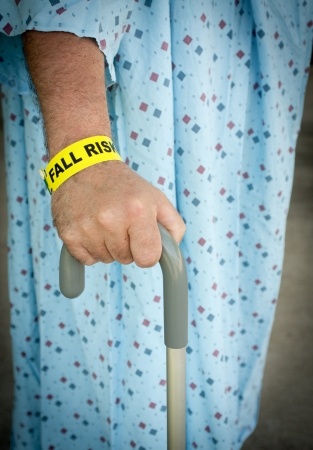Nursing Home Falls Are Preventable
January 14, 2015 | Category: Nursing Home Neglect/Abuse | Share Typically, in the United States, a 100-bed nursing home reports at least 100 to 200 falls per year according to the National Institutes of Health (NIH). Although a relatively small number (2% to 6 %) of falls result in fractures, 10% to 20 % of nursing home falls cause very serious injuries.
Typically, in the United States, a 100-bed nursing home reports at least 100 to 200 falls per year according to the National Institutes of Health (NIH). Although a relatively small number (2% to 6 %) of falls result in fractures, 10% to 20 % of nursing home falls cause very serious injuries.
The Centers for Disease Control (CDC) reports that 1,800 older adults who are living in nursing homes die each year as the result of fall-related injuries. Those who do survive these falls are frequently left with reduced quality of life and permanent disability.
What are the common causes of nursing home falls?(CDC)
- Muscle weakness and walking or gait problems are the most common causes of falls among nursing home residents. These problems account for about 24% of the falls in nursing homes.
-
Environmental hazards in nursing homes cause 16% to 27% of falls among residents. Such hazards include wet floors, poor lighting, incorrect bed height, and improperly fitted or maintained wheelchairs.
-
Medications can increase the risk of falls and fall-related injuries. Drugs that affect the central nervous system, such as sedatives and anti-anxiety drugs, are of particular concern. Fall risk is significantly elevated during the three days following any change in these types of medications.
-
Other causes of falls include difficulty in moving from one place to another (for example, from the bed to a chair), poor foot care, poorly fitting shoes, and improper, or incorrect, use of walking aids.
How can falls be reduced in nursing homes?
There are steps which nursing home providers need to take to protect residents. Dr. Laurence Rubenstein, Professor of Geriatric Medicine at UCLA said at an AMDA (Society for Post-Acute and Long-Term Care Medicine) Annual Symposium in 2001, "Every nursing home needs a standardized fall prevention program with environmental safety adaptations, as well as a systematic approach to assessing risk factors in individual residents."
Here are four steps, according to AMDA, nursing homes should address in their fall prevention programs:
Step 1: Identify the extent and circumstances of falls and injurious falls within the facility (i.e., who falls, location of falls, time or when falls take place, and why falls occur).
Step 2: Assess fall risk in all patients and residents and identify those at increased fall risk, especially those at risk for injurious falls.
AMDA further states that the residents who are at the greatest risk of falling include the cognitively impaired, those residents who need assistance to transfer and move safety, residents with a history of falls, anyone with vision problems, and residents on certain medications such as psychoactive drugs, diuretics, and medications that cause orthostatic hypotension.
Step 3: Based on the above steps, nursing homes should design appropriate multidisciplinary strategies and care plans to reduce fall and injury risk.
Probably the most common interventions are changes in medication, followed by an exercise program. Environmental modification is the next most likely change.
When the assessment indicates gait disturbances or weakness, especially in the lower extremities, patients benefit from physical therapy and strengthening and balance exercises. An exercise program is an effective intervention because exercise targets several risk factors.
Step 4: Consider the use of "safety technology" (e.g. fall alarms, hip protectors, etc.) to assist in preventing falls and injury.
Several devices that alert caregivers to patient movement or that protect patients from injuries from falls are currently being developed and marketed as possible alternatives to restraints for many high-risk patients. The most widely available devices are various alarm systems that are activated when patients try to get out of bed or move unassisted. Video recording systems are also being used as a means of providing closer monitoring of patient activities. Injury-prevention alternatives such as external hip protective pads and body-pillows are also being used to help prevent patient injuries.
Step 5: Monitor outcomes and redesign care plans as needed in those patients and residents who continue to fall or suffer injury.
"If your loved one has been injured from a fall or any other accident because of nursing home negligence and/or abuse, you will need a leading nursing home abuse attorney by your side. Florida and federal laws allow victims of nursing home abuse, and/or their loved ones, to file for civil damages for pain and suffering, medical negligence, financial exploitation, wrongful death, and more," says Lee, Collier, Charlotte County Nursing Home Abuse Attorney, Randall Spivey of Spivey Law Firm, Personal Injury Attorneys, P.A.
Southwest Florida Nursing Home Abuse Attorney, Randall L. Spivey is a Board Certified Trial Attorney – the highest recognition for competence bestowed by the Florida Bar and a distinction earned by just one (1%) percent of Florida attorneys. He has handled over 2,000 personal injury and wrongful death cases throughout Florida. For a free and confidential consultation to discuss your legal rights, contact the Spivey Law Firm, Personal Injury Attorneys, P.A., in Lee County at 239.337.7483 or toll free at 1.888.477.4839,or by email to Randall@SpiveyLaw.com. Visit SpiveyLaw.com for more information. You can contact Spivey Law Firm, Personal Injury Attorneys, P.A.in Charlotte County at 941.764.7748 and in Collier County 239.793.7748.

